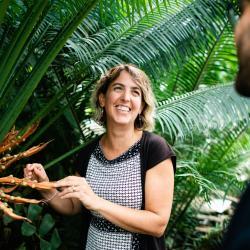Academic Holiday | Labor Day | All Day
University of Kentucky offices will be closed. Classes do not meet.
University of Kentucky offices will be closed. Classes do not meet.
University of Kentucky offices will be closed. Classes do not meet.
University of Kentucky offices will be closed. Classes do not meet.
University of Kentucky offices will be closed. Classes do not meet.

Bio:
Dr. Chelsea Specht is the Barbara McClintock Professor of Plant Biology and Associate Director for Faculty Development, Equity, and Inclusion in the School of Integrative Plant Science and serves as the elected Associate Dean of Faculty for Cornell University. She is a faculty member in the graduate fields of Plant Biology and Ecology and Evolutionary Biology and a faculty fellow of the Atkinson Center for a Sustainable Future. She is also a member of the L.H. Bailey Hortorium and affiliated with the Cornell University Herbarium.
In the Specht Lab we work together to investigate the evolution and diversification of Plant Form and Function. We use traditional morphological and developmental techniques combined with molecular genetics, comparative genomics and evolutionary biology to study the natural diversity of plants and to help better understand the forces creating and sustaining this diversity. Our research incorporates elements of systematics, developmental genetics and molecular evolution to study the patterns and processes associated with plant speciation and diversification. We take advantage of living and preserved collections to advance our research in plant systematics, biogeography, and developmental evolution.
Abstract:
Fifty years since Dr. Paul J.M. Maas published his first monograph of the New World Costoideae, we continue to struggle with species boundaries and evolutionary relationships within this charasmatic lineage of tropical monocotyledonous plants. In fact, the more we explore and discover the more questions emerge about the dynamics, patterns, and processes leading to speciation and diversification across the Neotropical Costaceae. In this seminar, I will discuss the recent monographic revision and its critical role in establishing a framework for evolutionary and ecological studies of the Neotropical Costus lineage within a phylogenetic context. The tempo and mode of speciation events are correlated with morphological changes that influence organismal interactions, including pollination and herbivory. Ecologic, morphologic, and biogeographic conditions that appear to promote hybridization and result in the potential for hybrid speciation are discussed across the genus, and implications for developing a stable taxonomy – and whether or not that is even possible or desirable – will be discussed.

Bio:
See attached CV here.
Abstract:
Determining what factors generate biodiversity is a central question in evolutionary biology. Despite its long history of study, we are only beginning to understand the evolutionary drivers of reproductive barriers between species, including reproductive barriers that manifest as sterile or dead hybrids. An intriguing hypothesis is that intragenomic conflicts- or selfish evolution- can drive the evolution of alleles that cause hybrid sterility/inviability. One such source of conflict is conflict between parents over resource allocation to offspring. Under parental conflict, multiple paternity drives the evolution of paternally derived, resource-acquiring alleles, and maternally derived alleles that distribute resources equally among offspring. In hybrids, mismatches between these parent-of-origin effect alleles can cause inappropriate development of placenta or endosperm, and subsequently embryo death. Here, I test the role of parental conflict in generating one of the most common intrinsic barriers in seed angiosperms- hybrid seed inviability-using members of the evolutionary and ecological model system; the Mimulus guttatus species complex. I show that hybrid seed inviability has evolved rapidly and repeatedly in this group, and patterns of HSI conform to the predictions of parental conflict. Additionally, genetic mapping suggests that hybrid seed inviability is conferred by nuclear, parent-of-origin effect loci (i.e. loci that affect the probability of death only if maternally or paternally derived). Lastly, using a series of natural surveys and mixed pollination crosses, I find that species with different histories of parental conflict frequently co-occur and hybridize, and hybridization between species with differing histories of parental conflict can indirectly influence growth in intraspecific seeds. Overall, this work highlights a dual role of parental conflict in the speciation process; both in the origin of reproductive isolation, but also in the dynamics and outcomes of hybridization in nature.
Watch the seminar here!

Bio:
Ricardo Mallarino is an Assistant Professor of Molecular Biology at Princeton University. Originally from Bogota, Colombia, he graduated with a B.S. in Biology from Universidad de los Andes. He completed his graduate studies at Harvard in Organismic and Evolutionary Biology in 2011, working with Arhat Abzhanov on developmental mechanisms underlying beak shape diversity in Darwin’s finches and their close relatives. After completing his PhD. he joined Hopi Hoekstra’s lab at Harvard, where he established a new model species and developed tools for studying the molecular basis of pigment pattern formation in mammals. Research in the Mallarino lab focuses on understanding the genetic and developmental mechanisms by which form and structure are regulated during vertebrate embryogenesis and elucidating how these processes get modified during evolutionary time to produce phenotypic diversity.
Abstract:
The evolution of metazoan organisms over millions of years has led to remarkable complexity of form and function. While biologists have long studied the ultimate causes of biological diversity (i.e., why it originates), the proximate mechanisms underlying its emergence (i.e., how it arises) remain largely unknown. The goal of my lab is to uncover the genetic and developmental mechanisms underlying the establishment of phenotypic traits and to understand how these mechanisms have evolved to generate diversity across species. We achieve this by harnessing naturally evolved phenotypic variation in ‘non-traditional’ species and integrating multiple disciplines, including developmental biology, computational biology, and evolutionary genetics. For the past six years, our research has focused primarily on patterning and evolution of novelty in mammalian skin. In this talk, I’ll describe how my lab has developed new model systems to study two distinct spatially patterned phenomena during skin development - stripe pattern formation in rodents and gliding membrane formation in marsupials. Through the use of experimental embryology, transcriptomics, comparative genomics, and functional genetics, our work has yielded insights into the mechanisms by which phenotypic novelty is generated at the molecular level.
Watch the seminar here!

Bio:
Dr. Tiago Simões started his career in his home city (Rio de Janeiro, Brazil), where he obtained his BSc and MSc in Biological Sciences- Zoology at the Federal University of Rio de Janeiro and the National Museum of Brazil. He obtained his PhD at the University of Alberta, Canada, in 2018 working with Dr. Michael Caldwell. Between 2019 and 2023 he was a Postdoctoral Fellow at the Museum of Comparative Zoology & Dpt. Organismic and Evolutionary Biology, Harvard University, working with Dr. Stephanie Pierce, and since 2022 a Research Associate in the Division of Vertebrate Zoology at the American Museum of Natural History. Since 2024, he has been an Assistant Professor in the Dpt. Ecology and Evolutionary Biology at Princeton University.
Dr. Simões’s research integrates data from living and extinct species, as well as morphological and genomic data, to investigate deep time problems in vertebrate evolution, with a special focus on the origin and early evolution of lizards and snakes. He has created several new morphological and total-evidence datasets employing state-of-the-art techniques in Bayesian phylogenetics and phylodynamics that helped bridging gaps between morphological and molecular hypothesis of reptile evolution. These studies, along with new technical advances in phylogenetics have been published in several peer-reviewed scientific articles creating, including in Nature, Nature Ecology & Evolution, and Science Advances.
:
The history of life on Earth is marked by complex interactions between species genomes and phenotypes across constantly changing environments. Therefore, it is necessary to investigate these interactions across deep evolutionary time to understand the processes responsible for the construction of both past and modern biological diversity. However, this line of research has historically faced several logistic and methodological limitations, such as the lack of quantitative methods for combining various data types sampled across vastly different organismal and temporal dimensions. Fortunately, the past decade has been testimony to several advances in Bayesian evolutionary analyses that have fostered the integration of data types towards more sophisticated inferences of evolutionary trees and macroevolutionary dynamics. Here, I will illustrate how I have used and expanded this class of techniques to integrate molecular and phenotypic data from living and fossil species to understand the patterns and processes operating across major evolutionary transitions in vertebrates, with a special focus on reptiles. These results have overhauled the structure of key areas of the reptile tree of life, including the origin of lizards and turtles, the interplay between phenotypic and molecular innovations during evolutionary transitions, and how these events have been impacted by climate change across deep time. I conclude by highlighting how a new omics era, integrating whole genomes and phenomes, can conciliate historical challenges in understanding organismal evolution and the interplay between genomes and phenotypes with their surrounding environments across broad taxonomic and time scales.
Watch the seminar here!
This will be an informational and Q&A Session with David Breach, Director of DRC.